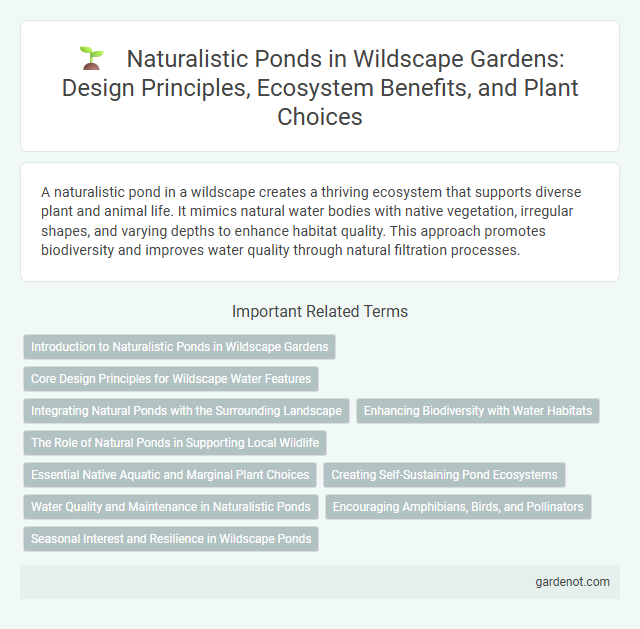A naturalistic pond in a wildscape creates a thriving ecosystem that supports diverse plant and animal life. It mimics natural water bodies with native vegetation, irregular shapes, and varying depths to enhance habitat quality. This approach promotes biodiversity and improves water quality through natural filtration processes.
Introduction to Naturalistic Ponds in Wildscape Gardens
Naturalistic ponds in Wildscape Gardens replicate natural aquatic ecosystems, promoting biodiversity and supporting native flora and fauna. Designed with irregular shapes, native plants, and shallow edges, these ponds provide habitats for amphibians, insects, and birds while enhancing ecological balance. Integrating sustainable water management, naturalistic ponds improve water quality and contribute to a thriving garden ecosystem.
Core Design Principles for Wildscape Water Features
Naturalistic ponds in wildscape design prioritize ecological balance, using native plant species and natural water filtration methods to create self-sustaining aquatic environments. Key design principles include mimicking natural water bodies' shape and depth variations to support diverse wildlife habitats and ensure water quality through minimal human intervention. Strategic placement of rocks, substrates, and emergent vegetation enhances habitat complexity, promoting biodiversity and resilience within the wildscape ecosystem.
Integrating Natural Ponds with the Surrounding Landscape
Naturalistic ponds seamlessly integrate with the surrounding landscape by using native plants, irregular shapes, and natural materials to mimic natural water bodies. These ponds support local biodiversity by providing habitats for amphibians, insects, and aquatic plants, enhancing the ecological value of Wildscape areas. Careful selection of native flora around the pond edges ensures erosion control and maintains water quality, promoting a balanced and sustainable ecosystem.
Enhancing Biodiversity with Water Habitats
Naturalistic ponds play a crucial role in enhancing biodiversity by providing diverse aquatic habitats that support various species such as amphibians, insects, and aquatic plants. These water habitats create ecological niches that promote the coexistence of flora and fauna, contributing to balanced ecosystems within wildscapes. Incorporating native plant species and maintaining water quality further boost habitat complexity and wildlife sustainability.
The Role of Natural Ponds in Supporting Local Wildlife
Naturalistic ponds create essential habitats that support biodiversity by providing water, food, and shelter for amphibians, insects, and birds. These ecosystems contribute to local wildlife conservation by maintaining natural water cycles and promoting native plant growth. Enhancing habitat complexity within ponds increases species richness and fosters ecological balance in surrounding environments.
Essential Native Aquatic and Marginal Plant Choices
Selecting essential native aquatic and marginal plants for a naturalistic pond enhances biodiversity and supports local wildlife. Species like water lilies (Nymphaea odorata), cattails (Typha latifolia), and pickerelweed (Pontederia cordata) provide habitat, improve water quality, and contribute to the pond's ecological balance. Incorporating a diverse range of native plants ensures resilience against invasive species and promotes a sustainable, self-sustaining aquatic ecosystem.
Creating Self-Sustaining Pond Ecosystems
Creating self-sustaining pond ecosystems in Wildscape involves incorporating native aquatic plants, beneficial microorganisms, and natural filtration systems that maintain water quality without chemical intervention. Designing varied depths and providing habitats for local wildlife support biodiversity and ecological balance. Continuous monitoring and minimal human disturbance ensure long-term pond health and resilience.
Water Quality and Maintenance in Naturalistic Ponds
Maintaining water quality in naturalistic ponds involves regular monitoring of pH, dissolved oxygen, and nutrient levels to support aquatic biodiversity and prevent algal blooms. Incorporating native aquatic plants like water lilies and cattails enhances filtration, stabilizes sediment, and provides habitat for wildlife. Effective pond maintenance includes managing runoff, minimizing chemical use, and periodically removing organic debris to sustain a balanced ecosystem.
Encouraging Amphibians, Birds, and Pollinators
A naturalistic pond designed within a wildscape provides ideal habitats for amphibians, birds, and pollinators by incorporating native aquatic plants and varied shoreline features. These elements create shelter, breeding grounds, and food sources essential for species like frogs, dragonflies, and hummingbirds, boosting local biodiversity. Maintaining clean water and diverse plant layers enhances ecological balance and supports the health of these wildlife populations.
Seasonal Interest and Resilience in Wildscape Ponds
Wildscape ponds designed with diverse native aquatic plants enhance seasonal interest by showcasing vibrant blooms and foliage changes throughout the year, supporting a dynamic ecosystem. These naturalistic ponds build resilience by fostering balanced microhabitats that tolerate fluctuations in water levels and temperature, ensuring sustained biodiversity. Integrating native species like water lilies, cattails, and pondweeds promotes ecological stability and attracts a variety of wildlife, reinforcing the pond's role in habitat conservation.
Naturalistic pond Infographic

 gardenot.com
gardenot.com